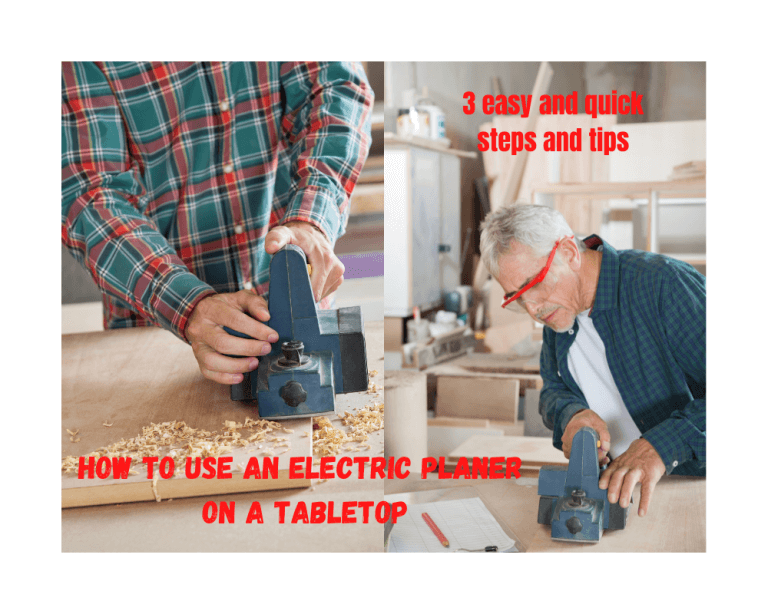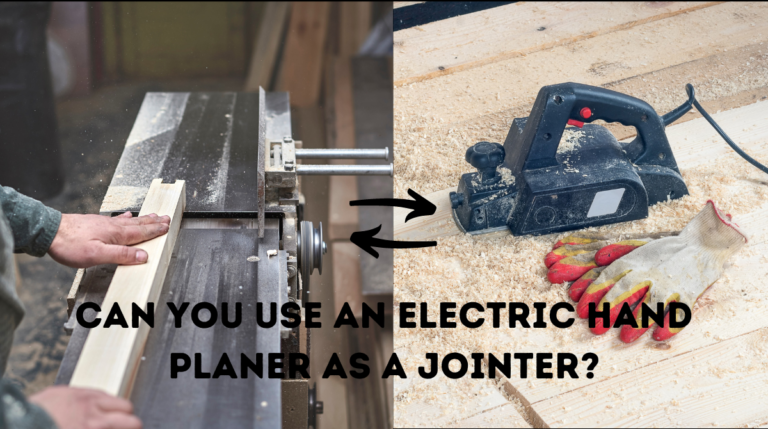Hand Planer Alternative – look at which one you can use!
As an Amazon Associate I earn from qualifying purchases.
A hand planer is a trimming and shaving tool that reduces the thickness of a twisted, warped, or uneven board, making the rough surface flat and smooth.
A hand planer alternative is needed so that we can plane, trim, or shave wood to reduce thickness when we don’t have access or in the absence of this dedicated tool for the dedicated project.
A hand planer can be both a manual hand planer and an electric hand planer; here in this article, I am discussing both tools manual, electric, and stationary alternatives so that one can easily have the best hand planer alternative for their projects and how to plane wood without a hand planer.
Contents
#9 Hand Planer Alternative Table
| Hand-held alternatives of hand planer | Stationary alternatives of hand planer | ||
| Electric hand planer Alternative | Manual hand planer Alternative | ||
| Wood router | Sandpaper | Benchtop thickness planer | |
| Belt sander or hand sander | Handsaw | Jointer | |
| Drum sander | Table saw | ||
| Band saw | |||
#3 effective Hand-held electric tool alternatives of hand planer
Wood Router
A wood router could be a superior alternative to a hand planer as it is a hand-held tool. Later, it uses a flat base and rotating bit or blade to cut a portion of the wood’s surface, and by cutting, shaving, or trimming the surface or edge of the wood, it planes, smooths, and flattens like a hand planer.
But some specific bits can do this job perfectly. For example, for broad surfaces, use a straight hinge mortising bit, bottom cleaning router bit, and slab-flattering router bit, and for edges, use a straight flush trim router bit and flute straight router bit.
The advantage of using a wood router is that you can shave deeper in a single pass to smooth rough surfaces and reclaim old wood. However, it has the disadvantage of covering or cutting a small, wide portion of the wood in a single pass, which takes a long time to plane a surface.
If one does not have a hand planer, he can use a wood router for shaping and trimming wood. It gives a similar result to a hand planer. Even any pattern of design can be made with this tool. Its diverse set of specifications made it a versatile tool and a suitable replacement for the Hand planer.
Belt sander or hand sander
A belt sander can be another alternative, as it smooths and flatten out large rough surfaces. Even can be used on hardwood floors or against the wall like a hand planer.
Choose specific grit sandpaper-like 40 to 60 to remove extra wood, and then use heavy 80 to 120 grit sandpaper to make a smother finish. Now all you have to do is turn on the machine and slide forth and back on the surface.
The advantage you get is that the wide surface of this tool and the fast rotating of the belt quickly cover large surfaces and strip down a block of wood in a quick time and do the task of a hand planer perfectly.
The disadvantage is that no depth settings exist, so you may over sand in some areas. So be conscious while sliding the hand-held belt sander or hand sander on the surface.
Drum sander
A drum sander works and can tackle many of the same jobs like a belt sander to replace hand planer on smoothing and flattening rough surfaces.
Choose the specific grit sandpaper like the belt sander, and also, you can choose higher grit sandpaper on the stationary drum sander to have a smoother finish. Now put the workpiece on the machine’s surface, and it will do the rest.
The advantage you get is that you can adjust the drum for depth thickness to have a straight, flat surface. Also, it can cover a wide surface at a time and strip down a block of wood in a quick time.
The disadvantage you get is that you can’t use it on the floor or against the wall as you have to slide the wood on it instead of sliding the tool on the workpiece like a hand planer. Also, you can’t use large wide boards on it as it has a fixed wide length.
#4 effective Stationary tools alternatives of hand planer
Benchtop Thickness planer
A benchtop thickness planer is a superior alternative to a hand planer. It can do all the work a portable electric hand planer and manual hand planer can do.
The advantage you get is that you can plane quicker and finer on it. Then, you just have to set the thickness you need and have to slide the board on the planer table.
The disadvantage you get is that you can use large wide boards on it as it has a size limitation.
Jointer
There is a common talk that a jointer is essentially just a planer, as a jointer can flatten the twisted or warped board or unequal surfaces, shaving extra wood chips from it.
Basically, a jointer is normally used before planing to flatten the twisted or warped board so that on a planer, you can shave off the wood on a desired thickness. But you can use it as an alternative when you don’t have a planer.
The advantage you get is that you can adjust the trimming depth and slide the workpiece on it; you can have straight and flat wood quickly like a hand planer.
The disadvantage you get is that, unlike the hand planer, you can’t use large wide boards on it and only can flat one side of the board.
Table saw
A table saw can be a great alternative to a hand plane to quickly and perfectly plane large boards. However, it can’t give you the perfect smooth finish like a hand planer, but it can reduce thickness and remove extra wood from a twisted, warped board to have a straight, flat surface.
To do this job perfectly, you can build a jig to keep the board in the right position and have to choose the higher tooth blade and move the blade toward the blade to get the finest finish.
The advantage you get is that you can trim or cut more extra wood and reduce thickness at a time and quickly from the twisted and warped board surface.
The disadvantage is that you may not get the smoothened surface, might get burn marks while cutting, and can’t cut more through extra wide boards.
Band saw
A band saw works and can tackle many of the same jobs as a table saw to replace a hand planer on reducing thickness for having a straight, flat surface over a twisted or warped board.
To do this job perfectly, you can build a jig or use the fence to keep the board in the right position and have to choose the wide blade and move the workpiece toward the blade to cut straight.
The advantage you get is that you can cut or reduce more thickness at a time and quickly from the twisted and warped board surface.
The disadvantage you get is that without the jig or fence, the cut won’t be much straight, and you can’t cut extra wide boards on it because of the fixed size and won’t get the smoothened finish like the hand planer.
#2 Effective hand-held Manual Tool Alternatives of hand planer
Sandpaper
As a woodworker, sandpaper is a common tool to have in your workshop, and absence of a hand planer; this can be an effective option for flitting and smoothing rough surfaces.
You should use low and heavy-grit coarsest-grade sandpaper to do your job perfectly. For removing material, use lower-grit sandpaper and higher-grit sandpaper to smooth the surface.
The advantage you get is that you can use it in tiny spaces and even longboards for sanding. But for longboards, you have to keep a long straight scale to check whether the surface got flat.
The disadvantage you get is that you have to use your muscles’ power to do sanding, and it takes more time to remove extra wood from the surface.
Handsaw
Like sandpaper, a handsaw is also a common tool in a workshop, and this hand tool can be a good alter to a hand planer.
A handsaw uses a sharp blade, and using the blade to make cuts on the surface; you can easily reduce thickness from a twisted and warped board. Also, you should use a flat straight board to have a long straight cut.
The advantage you get is that, at a time, you can cut more wood and reduce the maximum thickness to flatten the workpiece.
The disadvantage you get is that it is manual, takes more time to cut, and it’s tough to have a straight cut without a guideline mark or a flat straight board. Also, you don’t get enough smooth surface cutting with this handsaw.
Why do we need alternatives to Hand planer?
While working something like you have the rush to submit projects at the time and that time your hand planer is not functioning properly, or it could break, or where you are working, you don’t have access to this tool, or you are using an electric hand planer and don’t have electricity; on those time an alternative can be a lifesaving option.
How to straighten or plane wood without a hand planer?
The workpiece you are working with that may have a twisted or warped surface, and you may not have a hand planer at that time, even if you may not have any alternatives, as I mentioned earlier. You can try these techniques or steps to straighten your board or workpiece at that time without hand plane.
Steam method:
First, take a big bucket, put water in it, and heat the bucket. After that, take the twisted or warped and put it in the bucket, and make sure you don’t put it in the water. Then fully cover it with a lid so that the heat does not come out and the board takes all the moister.
Keep the wood piece there for several hours and then take it out and clamp it on a flat surface to put pressure on the wood piece. Then let it dry and cool overnight, then release the clamps to have a flat board. In this way, you can straighten a wood using the steam method.
Iron method:
First, put the wood piece on a flat surface. Then take a towel, cover both sides of the wood piece, and ensure the warped area is fully covered.
After that, spray some water to dampen the towel and then slide the hot steam iron on the warped or twisted area for 5 to 10 minutes, depending on the warped size, to have a flat board. In this way, you can straighten a wood using the iron method.
Sunlight method:
It’s a lengthy process among these two methods. To straighten a wood using the sunlight method, first, take a flat table in the sunlight. Then put the wood piece on a flat surface and cover both sides of the wood piece with a towel, and depending on the warped size, keep it in the sunlight for 2 or 3 days.
Within this time, spray water regularly multiple times on it and cover it with a plastic sheet so that the moister does not come out. Also, you can use clamps to put pressure on the warped area to fasten this process to have a flat wood piece.
Frequently Asked Questions
How to prevent tear out when cutting wood with a hand planer?
An incorrect feed direction which does change in the grain, can cause tear-out when cutting wood. To prevent that, you can use an adjustable mouth and steeper in a hand planer.
Also, if you somehow face a tear out of wood while working, you can use a card scraper to clean up the tear out.
How do you hand plane 2×4?
To hand plane 2×4 board, you must put your 2×4 board on a flat table or surface. Then with a jig or clamp, keep the board in one place so that it doesn’t move while planing. After that, take a hand planer and side it forth on the board surface multiple times to reduce the thickness to get the desired result.
Do you have to plane wood?
Yes, you need to plane wood to remove the extra wood from a wood surface to make it flat and smooth. To get the maximum level of perfection on your project, you need both a jointer and a planer. You can use these two to flatten and smooth your workpiece to have a finer finish.
Can a Dremel be used to sand wood?
You can use a Dremel to sand wood, but as it has a little head that rotates and sand for that, a small portion of the surface is good for sanding with a Dremel.
Conclusion
A hand planer is best for trimming and shaving extra wood from a surface to reduce the thickness of your need to make it flat and smooth. But in the absence of this tool or an access problem without any choice, you must use an alternative to finish the task on time.
I have given you all the possible alternatives that you can use instead of a hand planer. Now check which one you have access to use and have in your workshop. Thank you.






